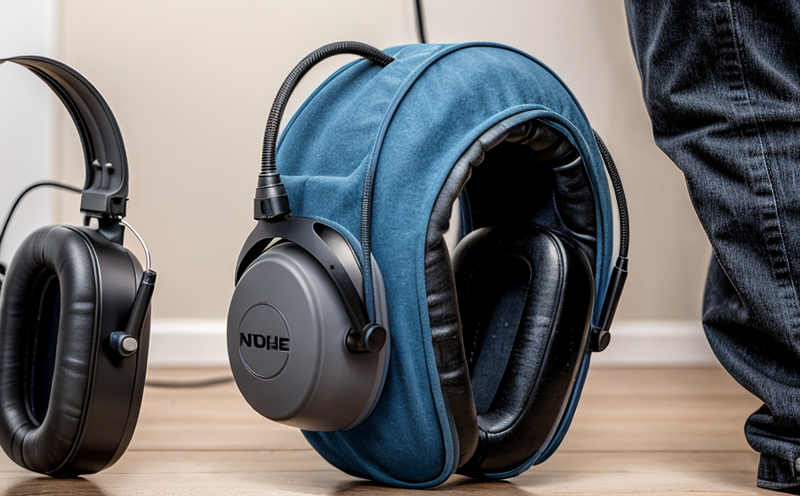DIN EN 352-7 Level Dependent Earmuff Testing
The DIN EN 352 series of standards is specifically designed to ensure that hearing protection equipment (HPE) meets the highest levels of performance and safety. The EN 352-7 standard pertains explicitly to level-dependent earmuffs, which are a critical component in protecting workers from hazardous noise environments.
In occupational settings where high-decibel noise is present, such as manufacturing plants or construction sites, the effectiveness of hearing protection devices (HPDs) can significantly impact worker health and safety. DIN EN 352-7 provides stringent criteria to assess the performance of level-dependent earmuffs in real-world conditions.
The standard requires that earmuffs undergo a series of tests to evaluate their ability to attenuate sound at various decibel levels. This ensures that the earmuffs provide adequate protection across different noise environments, thereby safeguarding workers from potential hearing damage and other health risks associated with prolonged exposure to loud noises.
Testing is conducted in controlled laboratory conditions using a calibrated sound source and an artificial head model designed to simulate human auditory response. The earmuffs are subjected to a range of noise levels, typically starting at 75 dB(A) and increasing by 10 dB increments until the maximum level required by the standard is reached.
During testing, the attenuation provided by the earmuffs is measured using specialized equipment such as sound level meters and anechoic chambers. The results are then compared against the specified performance criteria outlined in DIN EN 352-7 to ensure compliance with all relevant standards.
The process of testing level-dependent earmuffs involves several steps that ensure accuracy and reliability:
- Calibration: All measurement equipment is calibrated before testing begins to guarantee precise results.
- Test Setup: The artificial head model is positioned in the anechoic chamber, and the earmuffs are securely placed on it.
- Noise Generation: Noise of varying decibel levels is generated using a sound source.
- Data Collection: Attenuation data is collected as noise levels increase.
- Analysis: The collected data is analyzed against the performance criteria specified in DIN EN 352-7 to determine compliance.
The testing protocol ensures that level-dependent earmuffs meet stringent requirements, providing workers with reliable protection against hazardous noise. This standard plays a crucial role in occupational safety by validating the effectiveness of hearing protection devices across diverse industrial settings.
Compliance with DIN EN 352-7 is essential for manufacturers to ensure their products are safe and effective before they reach the market. For quality managers, compliance officers, R&D engineers, and procurement professionals involved in the design, testing, and certification of hearing protection equipment, this standard offers a robust framework for assessing product performance.
Quality and Reliability Assurance
Ensuring the reliability and accuracy of hearing protection devices is paramount to maintaining occupational safety standards. DIN EN 352-7 plays a critical role in this process by providing detailed guidelines on how to test level-dependent earmuffs effectively.
- Calibration and Standardization: The standard emphasizes the importance of equipment calibration, which ensures consistent and accurate measurement results.
- Test Conditions Replication: By simulating real-world noise environments, the testing protocol allows for the assessment of earmuff performance under various conditions.
- Data Validity Verification: The standard mandates that data from multiple tests be compared to verify its validity and reliability.
- Performance Criteria Compliance: Ensuring that the attenuation levels meet or exceed the specified criteria is crucial for product certification.
The rigorous testing process outlined in DIN EN 352-7 helps manufacturers identify any potential issues with their products early in the development stage. This approach not only enhances product quality but also contributes to worker safety by ensuring that hearing protection devices perform as expected in diverse occupational settings.
For compliance officers, this standard provides a clear and concise roadmap for validating that products meet international standards. It ensures that manufacturers adhere to best practices in testing, thereby contributing to the overall reliability of hearing protection equipment.
Environmental and Sustainability Contributions
The use of DIN EN 352-7 level-dependent earmuff testing contributes positively to environmental sustainability by promoting safer working conditions. By ensuring that hearing protection devices effectively reduce noise pollution, the standard helps minimize the environmental impact associated with hazardous noise in industrial settings.
Effective noise control through the use of compliant earmuffs reduces the need for more aggressive noise abatement measures such as soundproofing or other costly interventions. This not only saves resources but also promotes a healthier and safer work environment for employees.
The standard's emphasis on accuracy and reliability in testing ensures that workers are adequately protected, which can lead to reduced incidents of hearing loss and related health issues. In turn, this reduces the burden on healthcare systems and improves overall workplace productivity.
Manufacturers who adhere to DIN EN 352-7 standards demonstrate a commitment to sustainability by prioritizing worker safety and environmental protection. This aligns with broader corporate social responsibility goals, enhancing brand reputation and customer trust.
Competitive Advantage and Market Impact
The implementation of DIN EN 352-7 level-dependent earmuff testing offers significant competitive advantages for manufacturers in the hearing protection equipment industry. By ensuring that products meet stringent international standards, companies can differentiate themselves from competitors who may not adhere to such rigorous testing protocols.
Adherence to this standard also opens doors to new markets and opportunities for export, as many countries require compliance with international standards for imported goods. This enhances market access and expands the potential customer base.
The reliability and performance guarantees provided by DIN EN 352-7 can help manufacturers build a strong reputation in the industry. This reputation fosters long-term relationships with customers and stakeholders, contributing to sustained growth and profitability.
Moreover, compliance with this standard allows companies to meet regulatory requirements more easily, reducing the risk of penalties and legal disputes. This proactive approach not only minimizes operational risks but also enhances overall business efficiency.





